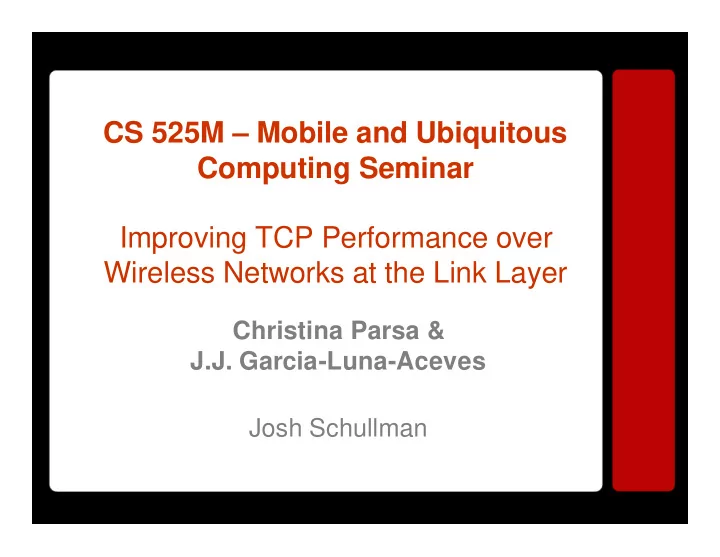

CS 525M – Mobile and Ubiquitous Computing Seminar Improving TCP Performance over Wireless Networks at the Link Layer Christina Parsa & J.J. Garcia-Luna-Aceves Josh Schullman
TULIP • TCP interprets packet loss as congestion! – Slow Start, Congestion Avoidance Visualization • T ransport U naware L ink I mprovement P rotocol – Service Aware , not Protocol Aware – Half-Duplex oriented – Stateless! • Decisions made on a per-destination basis – Maintains local recovery of all lost packets • Sliding window • Lost packet retransmission handled by sender’s link – Exploits TCP timeouts
Related Work • Link-Layer – AIRMAIL • Sends entire window of data prior to ACK response • Reduces ACK bandwidth consumption, power usage by mobile device • Must wait for end of window transmission for error correction; may lead to TCP timeouts • Split Connection – Split Source/Base/Mobile Receiver • Base station buffers, acknowledges packets to source not yet ACK’ed by receiver. Violates TCP!!! • Proxy – Proxy inserted between Sender/Receiver e.g., Snoop • Packet Sniffer, retransmits packets when detecting duplicate ACKs.
Service Basics… • Reliable Service – RLP (reliable link-level packet) • Guarantees in-order delivery w/out duplicates in a given timeout window – TCP data ± TCP ACK (TACK) • Unreliable Service – ULP (unreliable link-level packet) – TACK only • Assumption: +1 TACKs in transit – UDP packet – Link-level ACK (LACK)
Basic TULIP Operation • Packet interleaving requires transmission pacing per link, by maximum propagation delay ( τ ) • At most, one packet in-transit at MAC layer – TRANS: transmission started Send next packet after ∆ t 1 time • ∆ t 1 = t PCK + 2 τ + t ACK + 2 t TR + 2 t c + t p • WAIT: additional time to wait ( ∆ t 2 ) – • Allows self-regulation during bi-di transfer
Flow Control / Error Recovery • Transmitter utilizes sliding window (size W ) • Sequence numbers assigned modulo 2W • Sender/Receiver maintain buffer pools ( W ) • UnACKed transmission buffer (sender) • Retransmission list
Sender Algorithm
Receiver Algorithm
Sample Transmission • Retransmission list – R[sn i , … , sn n ] – R[sn i *] • Bit Vector – Represents Negative ACKs – CumACK N [0100…0] • Sequence N+1 NACK’ed
MAC-level Acceleration • Reduce transmission delays via cooperative TULIP/MAC interaction • FAMA receives data packet, sends to TULIP • TULIP notifies FAMA of packet payload – If size == 0, send ACK – Else if size <= 40, send packet + ACK – Else, send RTS to request channel – Why 40 bytes? Large enough to carry a TACK • Eliminates assumption that all packets are +40 bytes – In doing so, reduces MAC-level overhead to acquire the channel
MAC-level Acceleration • TRANS: acquired channel, data packet about to be transmitted • WAIT: received RTS (sends source address, packet size to link-layer)
Implementation • Implemented TULIP, Snoop in C++ Protocol Toolkit • Simulation based on same source code as WING prototypes • IEEE 802.11 physical layer emulation
Experiment 1: Throughput
Experiment 1: Goodput, Retransmissions
Experiment 1: RTT & Delay
Experiment 2: Throughput & Delay
Experiment 2: Delay
Experiment 3: Fading & Burst Losses
Experiment 3: Fading & Burst Losses
Conclusions • TULIP successfully hides packet loss from TCP • TULIP proves to be more successful at reducing timeouts due to varying BERs than Snoop • Exploits normal link-MAC layer interaction – Reduces bandwidth consumption, etc. • Last but not least, STATELESS!!! – Lends itself to be extremely scalable, since it is essentially TCP-version independent
Recommend
More recommend